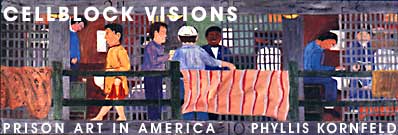
| Vision Things |

For almost a decade, Phyllis Kind, an art dealer and gallery owner, has included works by prisoners in the roster of "outsider artists" whom she represents. Phyllis Kornfeld, who teaches art to prisoners, has helped Ms. Kind locate works—monstrous, ironic, beautiful and inspired—that break through the popsicle-stick and pinup conventions of convict culture to articulate a more personal vision.
VAGUE spoke with Phyllis Kind in order to understand more about what such art means to prisoners and to the rest of us—art from the other side of the barbed wire.
VAGUE: Are all prison artists untrained?KIND: Some have had training and some not. But it's completely different from the outside world where people who have been to art schools are chummy-wummy with others in the same category. In prison it's a mix.
One of the prisoners, Daniel G. Watson (or "Stretch") has gone through his own self-educating process. He began by drawing the most horrible drawings—clowns with balloons, portraits of Uncle Sam. But suddenly he came into his own. He did a series of trucks—half underground—that was amazing. He's a lifer and spends a lot of time on his art.
He'll do realistic portraits of guys in his cell block in trade for favors, or these imaginative works because he knows people outside respond to them. Watson has a "let's-see-what-goes-over" style. Definitely a con man. The thing is, there are all kinds of con men, why not have some with talent?
Daniel Watson a.k.a. "Stretch" 1993
"Consume Consuming Consumers Now"Watson — "Although I see the negative possibility of the future, I don't think I'm really a cynic, because I believe that we humans are capable of reversing our present trends. I would like to think I'm part of that positive change."
VAGUE:Is art encouraged by the prison system?
KIND:It's getting tougher because of these "no frills" policies. Charles Mosby is an artist from Massachusetts. Really good. Jonathan Demme, the director, recently bought four of his paintings from me. One night, in the middle of the night, Charles was shackled by the ankles and wrists and taken to a county jail in Texas because of overcrowding in his state's prison. Texas would only take model prisoners and he was one, so they took him. Now his family in Massachusetts can no longer afford to visit him.
Charles Mosby — "Keeping in Shape"Mosby — "I turned to drawing because life here is very boring and depressing, and also a serious threat to my sanity. I had to find something to ease my mind."
He would write these letters to Phyllis Kornfeld saying, "It's been a year and I haven't been outside once. Even a dog gets to go outside once a day." Phyllis tried to send him her book, Cellblock Visions, because there are some color reproductions of his work in there, but they wouldn't let him have it. When she called the warden and asked if she could send Mr. Mosby colored pencils, the warden hung up on her.
VAGUE: Do prison artists continue their work once they get out?
KIND: A lot of prisoners stop painting altogether when they leave. Ronnie White got out and only did a little work which wasn't very good. But when he went back in again, he resumed his old style.
Ronnie White, 1991 — "Two Left Feet"White — "I want my work to be recognized for what it truly is, as pure as snow."
VAGUE: In what ways does prison life influence content?
KIND: Well, you'll see imagery, of course, but my favorite example is a prisoner I knew named Iovino who did the most wonderful, tiny drawings. When I asked him where he got the idea to make these little drawings he told me he couldn't make his pictures any bigger because he had such a small cell.
VAGUE: Do men and women do different kinds of work?
KIND: There aren't enough women doing it to make an answer meaningful. Most of the tiny percentage of prison painters who find a style of their own are lifers, and there are far fewer women in for life. Of those who are, most have been dominated by men and lack self-respect. Someone told one of the women lifers that they liked her painting and she said, "You like that?!?!" as in "What's wrong with you?!?!" It's hard to create a personal style from that place.
VAGUE: Are prisoners worried about revealing too much in such a guarded atmosphere?
KIND: You have to be careful about imagery. There are guards who'll take away your painting privileges if you paint a picture of a gun. Violent imagery can cost you parole. But, as to revealing emotion, Phyllis told me that the students in her classes who were at first the most hesitant to draw eventually got the most pleasure from it. They'd forget what they had been afraid of.
Photographs courtesy of Phyllis Kind Gallery, New York




 VAGUEpolitix > Focus on Crime > Vision Things > Back to Top >>
VAGUEpolitix > Focus on Crime > Vision Things > Back to Top >>